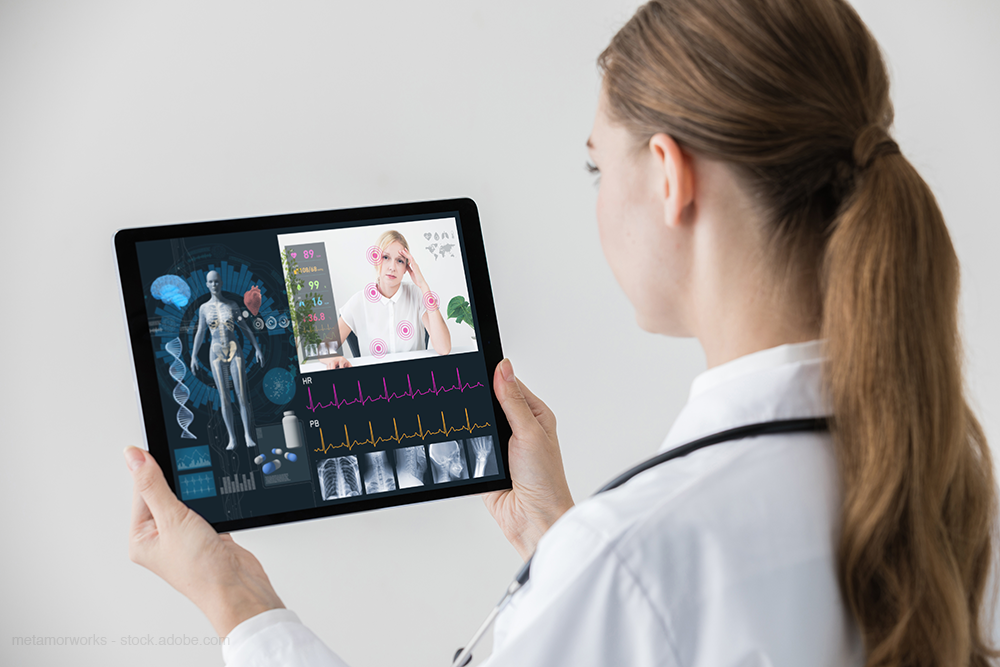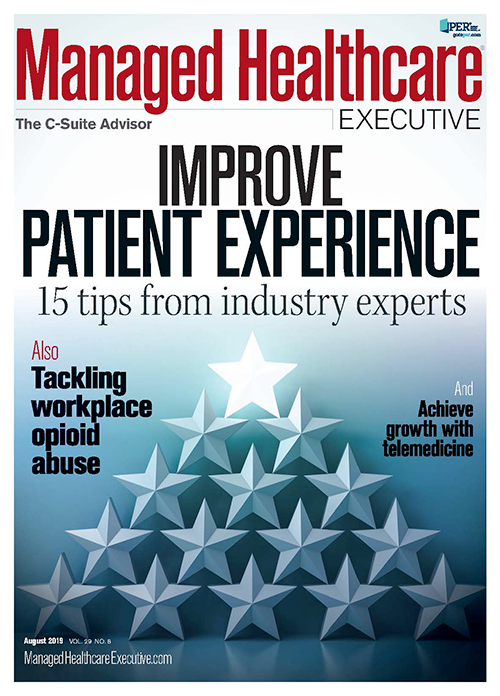Telemedicine and E-Visits: An Update
The state of telemedicine and remote patient monitoring.

As cardiac disease, diabetes, and other chronic illnesses rise worldwide, and as the population ages and the U.S. faces a predicted physician shortage, many health systems and health plans have embraced telemedicine as an option to grow their markets and continue care to patients remotely.
A study on health insurance claims from across the country found that between 2016 and 2017 telehealth claims increased by 53%-more than both urgent care centers (14%) and retails clinics (7%) combined.
“From a business perspective, if I can keep you healthier and more compliant with your physician recommendations, hopefully your health outcomes are going to be more positive. That means where we can potentially reduce readmission disease exacerbations and emergency room visits,” says Marya Vande-Doyle, director of workplace wellness and telemedicine for Excellus BlueCross BlueShield (BCBS). The health plan recently reported that nearly 15,000 telemedicine claims were filed in 2018. “We see telemedicine as a way to ensure that members feel like they have access to care wherever they go.”
Combined with market factors, CMS also accepted five new reimbursement codes in 2019 allowing for providers to be paid for remote patient monitoring, e-visits, and e-consults.
But even with a ripe market and more CMS support, experts believe that healthcare organizations still have a long way to go before telemedicine and e-visits are commonplace. Zynn says state regulations can still be a hurdle to telehealth adoption.
Related article: Telehealth Program Reduces Readmissions
“If you asked anybody in the industry, they would say licensing and changes in the regulations at the state level are probably the biggest hurdle or hindrance to faster growth,” says David Zynn, president of Infectious Disease (ID) Connect, a telemedicine company recently spun off from the University of Pittsburgh Medical Center (UPMC).
Currently, 29 states are a part of the Interstate Medical Licensure Compact, which provides streamlined licensure for physicians who offer telemedicine services through multiple states.
“In the next five years, we'll lose the term ‘tele’ because it will just be healthcare,” says Zynn. You will make an appointment to see your doctor and either go to the hospital or get that service via telemedicine. You will also get follow ups via telemedicine. So, it’s more efficient, more effective, and better for the patient.”
Using telehealth to expand specialists’ reach
UPMC saw telehealth as an opportunity to offer its expertise in infectious disease to communities across the country. The hospital launched a telemedicine company, ID Connect, to help other hospitals improve outcomes and reduce transfers for patients who need infectious disease treatment.
Currently, the program is being used by several other hospitals and outpatient clinics, with plans to expand in the upcoming months. A shortage of physicians who specialize in infectious disease, coupled with the constantly-evolving nature of the field were other catalysts to UPMC’s decision to create a technology company focused on providing services more broadly.
ID Connect incubated at UPMC for the past five years, and Zynn says that through that trial they were able to prove that telemedicine could contribute to a decrease in antibiotic misuse, patient hospital stays, and mortality. Currently, 12 doctors are providing services on the platform to other doctors who need assistance or second opinions, and to patients who are recommended to a specialist.
“Our doctors schedule tele-physical exams and we train our customers to use a tele-presenter. It is still is a very comprehensive exam, with questions, history, and a physical exam. The tele-presenter also has a video, so that our doctors can see and hear everything as if they were physically present,” Zynn says. “Our doctors can diagnose, treat, order labs and prescriptions, all documented in the EHR. They will follow up with that patient to make sure everything is working out as planned. They can make any changes to the diagnosis or treatment plan if necessary. And upon discharge, a telehealth appointment would be part of the discharge order and follow up.”
Zynn says that because there are more than 4,000 hospitals with 300 beds or less, it is increasingly important for smaller providers to have easy and affordable access to specialists. The U.S. could be short up to 122,000 physicians by 2032, with possibly half of them projected to be specialty care providers, according to a 2019 report from the Association of American Medical Colleges.
“I’ve talked to our customers and the number one thing that we bring to them is, without our service, they would have to transfer a lot of patients out to a larger tertiary. That’s not good patient service,” Zynn says. “It's not good for the local hospitals because they lose that patient. You don't want to take someone who is very sick with an infection and transport them from one facility into another. That alone is a tremendous opportunity to improve care.”
Health plans increasing telehealth outreach
Health plans are also seeing positive impacts to increased telehealth adoption. A recent claims review from Excellus BCBS in New York found that telehealth services have tripled in the past two years. The health plan’s review found that nearly 15,000 telemedicine claims were filed in 2018, up from 5,100 in 2016.
A survey of more than 2,000 Excellus BCBS members conducted in 2019 found that more than half of members knew about telemedicine and 43% said they would consider using it in the future. Though only 5% reported using telemedicine services, 93% who used it rated their experiences favorably.
An increase in community outreach and provider education are factors that led to the increase in telemedicine claims, Vande-Doyle says.
“We provided a public service campaign to help spread awareness using local media and partnering with community events, to help the community understand what a telemedicine visit is,” Vande-Doyle says.
Related article: New Payer-Technology Partnerships Could Be Telehealth’s Future
The second approach Excellus BCBS took was to work with network partners, health systems, and primary care providers based in the community and the local and state medical society to share why telemedicine is important. Excellus BCBS services Medicare, Medicaid managed care, commercial, and employer-based health plans.
“A vast majority of our population is located in either health professional shortage or metropolitan shortage areas as designated by HHS. We recognize that for those members it's very difficult for them to travel during a snow storm or find a caregiver to drive them to a doctor's appointment. We reached out to the medical community understanding these common challenges and how can we increase awareness of telemedicine,” Vande-Doyle says.
The Excellus BCBS survey results found that 78% of telehealth services were related to heart disease, hypertension, skin disorders, diabetes, and pneumonia. Another 22% of services were related to behavioral health, including anxiety, depression, attention and bipolar disorders. Behavioral health visits via telehealth were the fastest growing areas of treatment, according to the claims review.
“In order to be successful, we have to ensure that our providers feel comfortable in offering telemedicine. We have to encourage our providers to innovate. And at the same time, we have to share what we're learning,” Vande-Doyle says. “It's not focused on one specialty, healthcare provider, or one visit type. Telemedicine is for all types of applications. It's part of a solution of increasing access to care and using our healthcare services.”
More efficient pharmaceutical services
In the last decade, PipelineRx has grown its telepharmacy business to serve more than 600 hospitals and provider organizations, with 150 telepharmacists working from a call center or remotely. Brian Roberts, CEO of PipelineRx, says that remote dispensing and medication management, along with counseling patients and providers delivers education and efficiency that is lacking in the healthcare system.
“Telepharmacy increases access to facilities or organizations that either can't afford or can’t find the right pharmacy personnel. We can provide that remotely so that everybody has 24/7 care,” Roberts says. “I can take one telephone pharmacist working from home or from our call center, and they can cover between four and seven facilities at the same time. You can bring the overall cost of managing those facilities down by using telepharmacy.”
Roberts says that telepharmacy can allow on-staff pharmacists the ability to focus less on administrative tasks and work more closely with patients.
“We provide increased safety because a telepharmacist has his or her head down focusing on processing orders and making sure that the prescriptions are right,” Roberts says. “We actually counsel the patient during and after discharge to help them understand their medications and how adhere to their program.”
As rural pharmacies close across the country, and the importance of prescription drug management continues to rise, Roberts says telepharmacy can fill gaps in continuity of care.
Related article: FCC considers $100 million for rural telehealth program
“Transitions of care are such a big problem for the U.S. When a patient gets out of the hospital, information stops. If they have to pick up medications at the pharmacy, 40% of patients who leave the hospital either have a wrong prescription or they never pick up their medications,” Roberts says. “That 40% causes readmissions, it causes people to get sicker. We really like the impact that we can have by following patients out of the four walls of the hospital and allowing for the data streams to continue to follow them.”
The nationwide network developed through telepharmacy also allows for better tracking of medication abuse and misuse, Roberts says.
“Our data analytics and our pharmacists identify those that have a history of drug abuse or have been identified as a person who could be of high risk,” Roberts says. “We have access to see patient records across multiple settings and multiple hospitals. So, we can actually identify those who have gone to different hospitals trying to get opiates or other drugs.”
Donna Marbury is a writer in Columbus, Ohio.

In the Scope of Virtual Health and the Future of “Website” Manner, Per Ateev Mehrotra
August 10th 2023Briana Contreras, an editor of Managed Healthcare Executive, had the pleasure of catching up with MHE Editorial Advisory Board Member, Ateev Mehrotra, MD, MPH, who is a professor of healthcare policy at Harvard Medical School and an Associate Professor of Medicine and Hospitalist at Beth Israel Deaconess Medical Center.
Listen